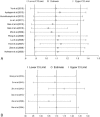Association of RAGE gene Gly82Ser polymorphism with coronary artery disease and ischemic stroke: A systematic review and meta-analysis
- PMID: 27930580
- PMCID: PMC5266052
- DOI: 10.1097/MD.0000000000005593
Association of RAGE gene Gly82Ser polymorphism with coronary artery disease and ischemic stroke: A systematic review and meta-analysis
Abstract
Background: The receptor for advanced glycosylation end products (RAGE) has been widely linked to diabetic atherosclerosis, but its effects on coronary artery disease (CAD) and ischemic stroke (IS) remain controversial. The Gly82Ser polymorphism is located in the ligand-binding V domain of RAGE, suggesting a possible influence of this variant on RAGE function. The aim of the present study is to clarify the association between the RAGE Gly82Ser polymorphism and susceptibility to CAD and IS.
Methods: Eligible studies were identified through a comprehensive literature search. Odds ratios (ORs) and 95% confidence intervals (CIs) were used to evaluate the association of Gly82Ser polymorphism with CAD and IS risk. Fixed- or random-effects model was used depending on the heterogeneity between studies. A funnel plot and Egger linear regression test were applied to assess publication bias. We also performed subgroup analyses to investigate potential sources of heterogeneity.
Results: A total of 16 eligible articles containing 18 studies were analyzed. The pooled analysis indicated that the Gly82Ser polymorphism significantly increased CAD risk in recessive and homozygous genetic models (SS vs GS + GG: OR = 1.34, 95% CI = 1.09-1.64; SS vs GG: OR = 1.38, 95% CI = 1.12-1.71). A significant association between the Gly82Ser polymorphism and IS risk was observed in all tested models except the heterozygous genetic model (GS + SS vs GG: OR = 1.20, 95% CI = 1.04-1.38; SS vs GS + GG: OR = 2.20, 95% CI = 1.74-2.78; SS vs GG: OR = 2.23, 95% CI = 1.72-2.91; S vs G: OR = 1.32, 95% CI = 1.05-1.65). Subgroup analysis suggested an association between CAD and IS risk and the Gly82Ser polymorphism in the Chinese population, but not in the non-Chinese population.
Conclusions: The current meta-analysis suggests that the RAGE Gly82Ser polymorphism is associated with an increased risk of CAD and IS, especially in the Chinese population. However, better-designed studies with larger sample sizes are needed to validate the results.
Conflict of interest statement
The authors have no conflicts of interest to disclose.
Figures





References
-
- Mozaffarian D, Benjamin EJ, Go AS, et al. Heart disease and stroke statistics—2016 update: a report from the American Heart Association. Circulation 2016;133:e38–60. - PubMed
-
- Conforto AB, Leite CC, Nomura CH, et al. Is there a consistent association between coronary heart disease and ischemic stroke caused by intracranial atherosclerosis? Arq Neuropsiquiatr 2013;71:320–6. - PubMed
-
- Mukherjee D. Peripheral and cerebrovascular atherosclerotic disease in diabetes mellitus. Best Pract Res Clin Endocrinol Metab 2009;23:335–45. - PubMed
-
- Soro-Paavonen A, Zhang WZ, Venardos K, et al. Advanced glycation end-products induce vascular dysfunction via resistance to nitric oxide and suppression of endothelial nitric oxide synthase. J Hypertens 2010;28:780–8. - PubMed
Publication types
MeSH terms
Substances
LinkOut - more resources
Full Text Sources
Other Literature Sources
Medical
Miscellaneous

